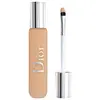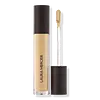Dior Backstage Face & Body Flash Perfector Concealer Versus Laura Mercier Flawless Fusion Ultra Longwear Concealer
What's inside
What's inside
 Key Ingredients
Key Ingredients

 Benefits
Benefits

 Concerns
Concerns

 Ingredients Side-by-side
Ingredients Side-by-side

Water
Skin ConditioningPhenyl Trimethicone
Skin ConditioningIsododecane
EmollientDimethicone
EmollientMethyl Trimethicone
Skin ConditioningGlycerin
HumectantMica
Cosmetic ColorantAcrylates/Dimethicone Copolymer
Skin ConditioningCetyl PEG/PPG-10/1 Dimethicone
EmulsifyingPEG-9 Polydimethylsiloxyethyl Dimethicone
EmulsifyingButylene Glycol
HumectantTrimethylsiloxysilicate
EmollientTrimethyl Pentaphenyl Trisiloxane
EmollientSodium Myristoyl Glutamate
CleansingDisteardimonium Hectorite
StabilisingPolysilicone-11
Synthetic Fluorphlogopite
Caprylyl Glycol
EmollientButyrospermum Parkii Butter
Skin ConditioningGlyceryl Undecyl Dimethicone
Propylene Carbonate
SolventLecithin
EmollientSodium Benzoate
MaskingAluminum Hydroxide
EmollientHexadecene
SolventCaffeine
Skin ConditioningHydroxyacetophenone
AntioxidantParfum
MaskingAscorbyl Glucoside
AntioxidantTocopherol
AntioxidantTin Oxide
AbrasiveCitric Acid
BufferingPentaerythrityl Tetra-Di-T-Butyl Hydroxyhydrocinnamate
AntioxidantCI 77891
Cosmetic ColorantCI 77491
Cosmetic ColorantCI 77492
Cosmetic ColorantCI 77499
Cosmetic ColorantWater, Phenyl Trimethicone, Isododecane, Dimethicone, Methyl Trimethicone, Glycerin, Mica, Acrylates/Dimethicone Copolymer, Cetyl PEG/PPG-10/1 Dimethicone, PEG-9 Polydimethylsiloxyethyl Dimethicone, Butylene Glycol, Trimethylsiloxysilicate, Trimethyl Pentaphenyl Trisiloxane, Sodium Myristoyl Glutamate, Disteardimonium Hectorite, Polysilicone-11, Synthetic Fluorphlogopite, Caprylyl Glycol, Butyrospermum Parkii Butter, Glyceryl Undecyl Dimethicone, Propylene Carbonate, Lecithin, Sodium Benzoate, Aluminum Hydroxide, Hexadecene, Caffeine, Hydroxyacetophenone, Parfum, Ascorbyl Glucoside, Tocopherol, Tin Oxide, Citric Acid, Pentaerythrityl Tetra-Di-T-Butyl Hydroxyhydrocinnamate, CI 77891, CI 77491, CI 77492, CI 77499
Water
Skin ConditioningCyclopentasiloxane
EmollientDodecane
PerfumingGlycerin
HumectantCetyl PEG/PPG-10/1 Dimethicone
EmulsifyingButylene Glycol
HumectantHeptyl Undecylenate
EmollientPhenyl Trimethicone
Skin ConditioningHydrogendimethylsiloxysilicate
Neopentyl Glycol Diheptanoate
EmollientBis-PEG/PPG-14/14 Dimethicone
EmollientSilica
AbrasiveQuaternium-90 Bentonite
Acrylates/C12-22 Alkyl Methacrylate Copolymer
Tribehenin
EmollientBoron Nitride
AbsorbentPolyglyceryl-3 Diisostearate
EmulsifyingLecithin
EmollientPentylene Glycol
Skin ConditioningDisodium Stearoyl Glutamate
CleansingDimethicone/Vinyl Dimethicone Crosspolymer
Skin ConditioningAscorbyl Glucoside
AntioxidantMagnesium Sulfate
Laureth-7
EmulsifyingPropylene Carbonate
SolventAluminum Dimyristate
Emulsion StabilisingTriethoxycaprylylsilane
Serica
HumectantTrisodium EDTA
Phenoxyethanol
PreservativeCaprylyl Glycol
EmollientChlorphenesin
AntimicrobialMica
Cosmetic ColorantCI 77891
Cosmetic ColorantCI 77491
Cosmetic ColorantCI 77492
Cosmetic ColorantCI 77499
Cosmetic ColorantWater, Cyclopentasiloxane, Dodecane, Glycerin, Cetyl PEG/PPG-10/1 Dimethicone, Butylene Glycol, Heptyl Undecylenate, Phenyl Trimethicone, Hydrogendimethylsiloxysilicate, Neopentyl Glycol Diheptanoate, Bis-PEG/PPG-14/14 Dimethicone, Silica, Quaternium-90 Bentonite, Acrylates/C12-22 Alkyl Methacrylate Copolymer, Tribehenin, Boron Nitride, Polyglyceryl-3 Diisostearate, Lecithin, Pentylene Glycol, Disodium Stearoyl Glutamate, Dimethicone/Vinyl Dimethicone Crosspolymer, Ascorbyl Glucoside, Magnesium Sulfate, Laureth-7, Propylene Carbonate, Aluminum Dimyristate, Triethoxycaprylylsilane, Serica, Trisodium EDTA, Phenoxyethanol, Caprylyl Glycol, Chlorphenesin, Mica, CI 77891, CI 77491, CI 77492, CI 77499
 Reviews
Reviews

Ingredients Explained
These ingredients are found in both products.
Ingredients higher up in an ingredient list are typically present in a larger amount.
Ascorbyl Glucoside is a stable form of Vitamin C. It is created by combining glucose from starch.
When applied to skin, Ascorbyl Glucoside turns into Ascorbic Acid.
Ascorbyl Glucoside is an antioxidant. Antioxidants help fight free-radicals, or molecules that may damage skin cells.
It can help to reduce redness, improve skin texture, reduce the effects of aging, reduce the visibility of dark spots, and brighten skin.
Read more about other types of Vitamin C:
Learn more about Ascorbyl GlucosideButylene Glycol (or BG) is used within cosmetic products for a few different reasons:
Overall, Butylene Glycol is a safe and well-rounded ingredient that works well with other ingredients.
Though this ingredient works well with most skin types, some people with sensitive skin may experience a reaction such as allergic rashes, closed comedones, or itchiness.
Learn more about Butylene GlycolCaprylyl Glycol is a humectant and emollient, meaning it attracts and preserves moisture.
It is a common ingredient in many products, especially those designed to hydrate skin. The primary benefits are retaining moisture, skin softening, and promoting a healthy skin barrier.
Though Caprylyl Glycol is an alcohol derived from fatty acids, it is not the kind that can dry out skin.
This ingredient is also used as a preservative to extend the life of products. It has slight antimicrobial properties.
Learn more about Caprylyl GlycolThis ingredient is a high molecular weight silicone. It has emulsifying and skin conditioning properties.
Ci 77491 is also hydrated iron III oxide. It's sole purpose is to give a red/pink hue to products.
Iron III oxides are classified as inorganic chemicals for coloring.
Synthetically created Ci 77491 is considered safer than those naturally found. This is because the synthetically created version may contain less impurities. Iron oxides are generally non-toxic and non-allergenic.
Learn more about CI 77491Ci 77492 is also hydrated iron III oxide. It's sole purpose is to give a yellow hue to products.
Iron III oxides are classified as inorganic chemicals for coloring.
Synthetically created Ci 77492 is considered safer than those naturally found. This is because the synthetically created version may contain less impurities. Iron oxides are generally non-toxic and non-allergenic.
Learn more about CI 77492Ci 77499 is also hydrated iron III oxide. It is created from mixing red and black iron oxides. This helps give shades of darkness to a product.
Iron III oxides are classified as inorganic chemicals for coloring.
Ci 77891 is a white pigment from Titanium dioxide. It is naturally found in minerals such as rutile and ilmenite.
It's main function is to add a white color to cosmetics. It can also be mixed with other colors to create different shades.
Ci 77891 is commonly found in sunscreens due to its ability to block UV rays.
Learn more about CI 77891Glycerin is already naturally found in your skin. It helps moisturize and protect your skin.
A study from 2016 found glycerin to be more effective as a humectant than AHAs and hyaluronic acid.
As a humectant, it helps the skin stay hydrated by pulling moisture to your skin. The low molecular weight of glycerin allows it to pull moisture into the deeper layers of your skin.
Hydrated skin improves your skin barrier; Your skin barrier helps protect against irritants and bacteria.
Glycerin has also been found to have antimicrobial and antiviral properties. Due to these properties, glycerin is often used in wound and burn treatments.
In cosmetics, glycerin is usually derived from plants such as soybean or palm. However, it can also be sourced from animals, such as tallow or animal fat.
This ingredient is organic, colorless, odorless, and non-toxic.
Glycerin is the name for this ingredient in American English. British English uses Glycerol/Glycerine.
Learn more about GlycerinLecithin is a term for a group of substances found in the cell membranes of plants, animals, and humans. They are made up of mixture of phospholipids.
This ingredient has emollient and emulsifying properties.
As an emollient, lecithen helps soften the skin and creates a barrier to keep moisture in.
As an emulsifier, it also helps prevent water and oil ingredients from separating. Lecithin can also help ingredients be better absorbed by the skin.
This is because the phospholipids in lecithin produce liposomes. Liposomes help other ingredients get through the skin barrier.
Depending on the source of this ingredient, lecithin may not be fungal acne safe. This is because some sources of lecithin come from soybean oil, which may feed the malassezia yeast that feeds fungal acne.
We recommend reaching out to the brand you are purchasing from to inquire about the source of their lecithin.
Some other names for this ingredient include soy lecithin and deoiled soy lecithin.
Learn more about LecithinMica is a naturally occurring mineral used to add shimmer and color in cosmetics. It can also help improve the texture of a product or give it an opaque, white/silver color.
Serecite is the name for very fine but ragged grains of mica.
This ingredient is often coated with metal oxides like titanium dioxide. Trace amounts of heavy metals may be found in mica, but these metals are not harmful in our personal products.
Mica has been used since prehistoric times throughout the world. Ancient Egyptian, Indian, Greek, Roman, Aztec, and Chinese civilizations have used mica.
Learn more about MicaPhenyl Trimethicone is a silicon-based polymer. It is derived from silica.
Phenyl Trimethicone is used as an emollient and prevents products from foaming.
As an emollient, it helps trap moisture in the skin. It is considered an occlusive.
Learn more about Phenyl TrimethiconeThis ingredient is a solvent. It helps dissolve active ingredients and alter the texture of products.
Propylene Carbonate is commonly used in makeup and with clay, such as montmorillonite or bentonite.
Studies show this ingredient to be safe for cosmetics. When it is undiluted, it can cause skin irritation. (It is always diluted in skincare and makeup). This ingredient is water-soluble.
Propylene Carbonate is created from propylene glycol and carbonic acid.
Learn more about Propylene CarbonateWater. It's the most common cosmetic ingredient of all. You'll usually see it at the top of ingredient lists, meaning that it makes up the largest part of the product.
So why is it so popular? Water most often acts as a solvent - this means that it helps dissolve other ingredients into the formulation.
You'll also recognize water as that liquid we all need to stay alive. If you see this, drink a glass of water. Stay hydrated!
Learn more about Water